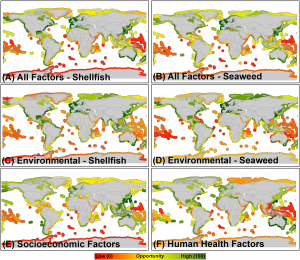
NCCOS spatial science shows where marine aquaculture can benefit both nature and people, and these findings were highlighted in international aquaculture news. The Global Seafood Alliance, a non-governmental organization dedicated to advocacy, education and leadership in responsible aquaculture, recently published a news article Identifying global opportunities for shellfish, seaweed aquaculture. The article summarizes the results from a joint effort by NCCOS and The Nature Conservancy (TNC) published in the journal PLOS ONE.
The highlighted NCCOS/TNC PLOS ONE journal publication identifies marine ecoregions with the greatest potential for development of shellfish and seaweed aquaculture that would simultaneously advance coastal ecosystem recovery and provide substantive benefits to humanity. The study also provides insights on prioritizing efforts to change public policy, build capacity, and demonstrate the ecosystem and societal benefits of shellfish and seaweed aquaculture.
Citation: Theuerkauf, Seth J., James A. Morris Jr., Tiffany J. Waters, Lisa C. Wickliffe, Heidi K. Alleway and Robert C. Jones. 2019. A global spatial analysis reveals where marine aquaculture can benefit nature and people. PLOS ONE, October 9, 2019. https://doi.org/10.1371/journal.pone.0222282
